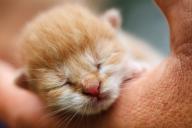When cats dislike their food, you can clearly see it - but only if you understand the signs.
Like other animals, cats can be picky, but they also can sense when their food is spoiled or bad for them.
Here are the signs that might signalize that it's time to change your cat's food.

Pawing or Scratching
Some cats may display their displeasure by pawing at the food as if they're trying to bury it.
This behavior mimics what cats do when they want to hide something they dislike. It's their way of saying, "I don't want this."
Sniffing and Walking Away
Cats have an excellent sense of smell, and they rely on it to assess their food.
If they sniff the food and then walk away without taking a bite, it suggests they are not interested in what's in the bowl.
Licking and Chewing Slowly
Cats that lick their food slowly or chew it with hesitation might not find it very tasty.
They may be trying to eat as little as possible because they don't like the flavor or texture.
Vomiting
If your cat frequently throws up after eating, it could be a sign of food intolerance or dislike.
Vomiting can occur when a cat's stomach rejects the food, and they try to get rid of it.
Reduced Appetite
Cats are creatures of habit. If your cat constantly eats less than usual or skips meals when a particular food is offered, it's a sign of food aversion.
They might be waiting for something better or simply refusing to eat what's in their bowl.
Conclusion
It's crucial to observe your cat's reactions to their food and make adjustments accordingly.
Cats have individual preferences, and finding the right food that they enjoy and is suitable for their health is essential for their well-being.













